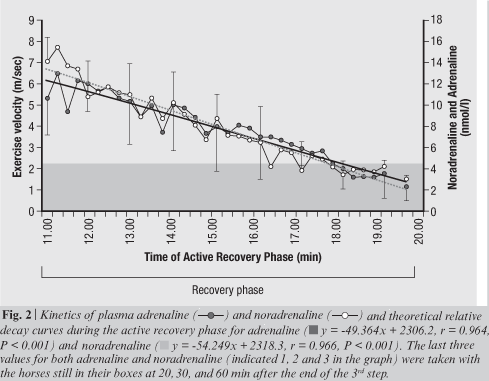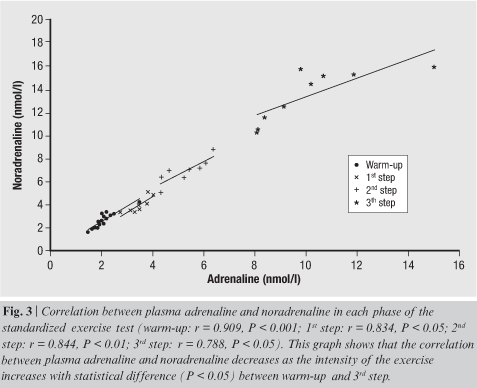BRIEF NOTES
Brief note about plasma catecholamines kinetics and submaximal exercise in untrained standardbreds
Breve nota sulla cinetica delle catecolamine plasmatiche in cavalli da trotto non allenati durante esercizio sub massimale
Paolo BaragliI; Sara PacchiniI; Domenico GattaII; Michele DucciI; Claudio SighieriI
IDipartimento di Scienze Fisiologiche
IIDipartimento di Produzioni Animali, Università degli Studi, Pisa, Italy
SUMMARY
Four untrained standardbred horses performed a standardized exercise test on the treadmill and an automated blood collection system programmed to obtain blood samples every 15 s was used for blood collection in order to evaluate the kinetics of adrenaline and noradrenaline. The highest average values obtained for adrenaline and noradrenaline were 15.0 ± 3.0 and 15.8 ± 2.8 nmol/l respectively, with exponential accumulation of adrenaline (r = 0.977) and noradrenaline (r = 0.976) during the test. Analysis of the correlation between noradrenaline and adrenaline for each phase of the test shows that correlation coefficient decreases as the intensity of exercise increases (from r = 0.909 to r = 0.788). This suggests that during submaximal exercise, the process for release, distribution and clearance of adrenaline into blood circulation differs from that of noradrenaline.
Key words: standardbreds horses, epinephrine, norepinephrine, exercise, kinetics.
RIASSUNTO
Nel presente lavoro quattro cavalli trottatori non allenati hanno effettuato un test di esercizio standardizzato sul treadmill, durante il quale sono stati eseguiti prelievi di sangue ogni 15 secondi mediante un sistema automatizzato. Lo scopo è stato valutare la cinetica di adrenalina e noradrenalina. I valori massimali di adrenalina e noradrenalina sono risultati essere rispettivamente 15,0 ± 3.0 e 15,8 ± 2,8 nmol/l con un accumulo plasmatico di tipo esponenziale per l'adrenalina (r = 0,977) e la noradrenalina (r = 0,976). L'analisi della correlazione fra adrenalina e noradrenalina mostra come il coefficiente di correlazione diminuisce con l'aumentare dell'intensità dell'esercizio (da r = 0,909 a r = 0,788) e questo suggerisce ci sia una differenza nel processo di rilascio, distribuzione e clearance fra adrenalina e noradrenalina nei cavalli durante l'esercizio fisico submassimale.
Parole chiave: cavalli trottatori, epinefrina, norapinefrina, esercizio fisico, cinetica.
INTRODUCTION
Catecholamines play a fundamental role in the physiology of exercise in all animal species, since they regulate many biochemical processes involved in energy metabolism as well as the adaptation of organism homeostasis to physical activity [1]. The action of these molecules is reflected in many physiological functions, such as increased heart rate, blood pressure, sweating, mobilization of energetic substrates and respiratory rate [2]. Few studies exist regarding variations of plasma catecholamines concentration in horses during physical activity [3-7]. This is mainly due to difficulties in assessment, since these variations, whether reflected in increased blood levels of catecholamines or by their short half-lives, tend to occur very rapidly. Some authors reported a six- and seven-fold increase over basal values respectively for noradrenaline and adrenaline levels in thoroughbred horses, when blood was collected by venipuncture 5 min after the end of a regular race [8]. Subsequent studies confirmed that the manual collection of a single blood sample, taken from the jugular vein by venipuncture, is an inadequate technique for accurate measurement of these molecules [4], according to a previous report by Persson [9], who hypothesized that the procedure itself could induce stress in the animal. Snow et al. [3] using a manual sampling method [10] reported a 148- and 67- fold increase in adrenaline and noradrenaline respectively, compared to basal values. The blood collection technique used in this study allowed the authors to collect blood during exercise; this allowed to observe an exponential increase in both adrenaline and noradrenaline in relation to the exercise itself, without however indicating the equation of these curves. The first indication of a statistically proven exponential accumulation was presented by Kurosawa et al. [5]; using the same collection technique, they obtained statistical confirmation of the exponential accumulation of both adrenaline and noradrenaline, which varied with the intensity of the exercise. Nevertheless, due to the specific metabolic characteristics of these molecules, even short 30-s intervals between single measurements may be insufficient to permit recognition of any variations. Furthermore, the collection technique used by the above mentioned authors is considerably influenced by the operator's manual skill, thus presenting reproducibility problems. Therefore, we believe that in order to adequately evaluate the kinetics of plasma catecholamines during exercise, it is necessary to adopt greatest possible standardization of both time intervals and blood collection method. In our experiment, an automated continuous blood collection system, previously utilized in both humans [11] and animals [12] was adapted for horses by our research group [13] to evaluate the kinetics of plasma catecholamines in untrained standardbreds during a single session of submaximal treadmill exercise.
MATERIALS AND METHODS
Animals
Four standardbred geldings age 4-7 years were used in this study. Clinical examination confirmed that the subjects were in healthy condition and well-adapted to treadmill work. For a 2-month period prior to the test, subjects were kept in their box stalls except for a 1-h daily period in the paddock, to ensure that all subjects had a similar physical condition and level of training; all subjects received a maintenance diet during this period. Each activity involving horses was regulated by the "Italian Animal Care" (DL.vo 116/92), Department reference number 87/3.0.7.
Experimental design
The automatic blood collection technique, specifically applied for this type of study and the preparation of the horses for the test are reported in bibliography [13]. The day after the insertion of the catheter, the horses underwent a standardized exercise test (SET) on a treadmill (mod. SATO II, SATO, Stockholm, Sweden) during which the blood collection procedure was carried out. All subjects had fasted since the day before the test. The test was carried out during a two-day period (testing two horses per day) under similar environmental conditions (average temperature 21 ± 3 °C and average humidity 75 ± 8%). Prior to the beginning of the test, in order to determine the basal values of adrenaline and noradrenaline a blood sample was drawn while the horses were still in their boxes, in conditions of absolute rest. The SET procedure was divided into four phases: 4.5 min at 1.8 m/s (warm-up), 2 min at 120 beats/min (1st step), 2 min at 160 beats/min (2nd step) and 2 min at 200 beats/min of heart rate which is equivalent to a work intensity of approximately 90% VO2max [14]. Heart rate was controlled by means of a heart rate monitor (Polar RS800, Polar Electro Oy, Kempele, Finland). The SET was followed by an Active Recovery Phase (ARP) consisting of 10 min walking on treadmill at 1.8 m/s. The entire exercise was conducted with a treadmill inclination of 3.5% and the heart rate was recorded for the duration of the test. The automatic fraction collector used in the automated blood collection system was programmed to obtain blood samples every 15 s. The automatic blood collection procedure lasted for a period of 19 min, from the beginning of the exercise until 9 min after the end of the SET; subsequent blood samples were drawn manually from the venous catheter at 10 (at the end of recovery phase on treadmill) and 20 min after the end of the SET (with the horses still in their boxes).
Blood sampling and treatment
The standardized method consisted on blood collection by means of an automatic fraction collector using heparinized test tubes immersed in an ice bath, which kept the blood samples at a temperature below 10 °C, thus slowing the normally rapid degradation of catecholamines. The manually-obtained samples were refrigerated and treated in the same manner. Test tubes were immediately centrifuged at 3000 g for 10 min at 10 °C in a refrigerated centrifuge located in a room next to the treadmill room. The plasma obtained was then quickly transferred to test tubes containing perchloric acid (0.2 N) for rapid deproteinization. Time from collection to the deproteinization was 20 min. Test tubes prepared in this way could then be frozen at - 70 °C for two months before analysis [15]. Extraction and determination of plasma catecholamines were performed using a commercial kit (Bioanswers s.a.s., Torino, Italy) in an HPLC system (HPLC-Fl). The HPLC system included the pump (PU-158) and fluorimetric detector (FP 920) (Jasco Europe s.r.l., Cremalla, Como, Italy) with excitation and emission wavelengths of 285 nm and 315 nm respectively. Chromatography was performed by a column LiChroCART 250-4,6 Purospher STAR RP 18 (Merck KGaA, Darmstadt, Germany) endcapped 5 mm at the temperature of 35 °C in isocratic conditions of mobile phase and flow of 1 ml/min. Sensitivity of the overall system was 0.3 nmol adrenaline/l and 0.2 nmol noradrenaline/l with a variation between duplicate analyses of less than 7% for adrenaline and 5% for noradrenaline.
Statistical analysis
Statistical analysis was carried out by means of one-way analysis of variance (ANOVA) on linear regression and Pearson's correlation coefficient. Test were carried out with Primer of Biostatistics 5.0© by Stanton A. Glantz [16].
RESULTS
Samples taken from the fasting subjects at rest in their stalls before the test yielded basal values of 0.7 ± 0.3 nmol/l and 1.2 ± 0.4 nmol/l respectively for adrenaline and noradrenaline. The highest concentrations were obtained for both adrenaline and noradrenaline at the end of the SET with values of 15.0 ± 3.0 nmol/l for adrenaline and 15.8 ± 2.8 nmol/l for noradrenaline. These data show a 21-fold increase for adrenaline and a 13-fold increase for noradrenaline from the basal value (basal values represent 4.8% and 7.4% respectively of the highest values of adrenaline and noradrenaline). For the period covering the SET, mathematical analysis revealed an exponential accumulation curve for both noradrenaline and adrenaline (Figure 1). Instead, during the active recovery phase (ARP) the kinetics of the decrease in plasma concentration of catecholamines show a linear progression (Figure 2). Furthermore, we wish to underline that 10 min after the end of the SET, plasma concentrations of adrenaline (2.4 ± 0.5 nmol/l) and noradrenaline (3.1 ± 1.8 pg/ml) were still high (3.4 times the basal value for adrenaline and 2.6 times the basal value for noradrenaline). Breaking the SET down into its four phases (warm-up, 1st, 2nd and 3rd step) and performing an analysis of the correlation between adrenaline and noradrenaline (Figure 3), we show that in each step the correlation is always linear but that the correlation coefficient decreases as the intensity of the exercise increases, with statistical difference (P < 0.05) between warm-up and the 3rd step.



DISCUSSION AND CONCLUSION
The blood collection method used in this study allowed us to accurately analyze the kinetics of plasma catecholamines during a single submaximal exercise session on treadmill performed by untrained standardbreds both during the test itself and in the subsequent post-exercise recovery phase. The data show an increase in the plasma concentration of catecholamines during the SET up to the level of maximum intensity exercise. The noradrenaline values close to maximum concentration occurred in the initial part of the 3rd step and are sustained, with slight variations, for the entire duration of the step until the maximum peak of concentration. On the other hand, values for adrenaline reached their peak only at the end of the 3rd step. The highest average values for both adrenaline and noradrenaline in this experimental protocol appear to agree with the hypothesis that the adrenal medulla (the principal source for the release of adrenaline during physical stress [17]) plays a more important role in horses than in humans in sustaining response to physical exercise. This hypothesis was previously proposed by other authors [3]. Mathematical analysis showed an exponential accumulation of plasma catecholamines during the Set depending on the intensity of the exercise, in agreement with results reported by Kurosawa et al. [5]. Both Snow and Kurosawa used trained thoroughbreds for their experiments, while in our study untrained standardbreds were used. A comparative analogy of the kinetics of the plasma catecholamines would appear to indicate that during fairly intense physical exercise there are no substantial differences in the activation process of the sympatho-adrenergic system between trained and untrained subjects. However, the situation appears to be different regarding the recovery phase after a period of high-intensity exercise. In our experiment we showed that the decrease in plasma concentrations of noradrenaline and adrenaline during the ARP occurs in a linear way and not very rapidly. Ten minutes after the end of the SET, noradrenaline and adrenaline values didn't return to basal levels, in apparent contrast to their very short plasma half-lives [3]. The hypothesis explaining these data could be related to the quantity of noradrena-line and adrenaline released after the end of the exercise, resulting from the moderate intensity exercise performed in the recovery phase, as reported by others authors [6]. It is interesting to note that the analysis of the standard deviation seen in the ARP reveals that the influence of individual variability is considerable, and higher than in the SET. The great variability of the sympatho-adrenergic response in different individuals is an established fact, which has been verified in both humans [18] and horses [3, 4] and reflects individual variations in response to exercise-induced stress. In our tests the wide variability recorded in the ARP, along with the previously mentioned hypothesis that a certain amount of sympatho-adrenergic activity persists in this phase (as reflected by the longer time required for the plasma concentrations of adrenaline and noradrenaline to decrease compared to trained subjects) may indicate that since our subjects were untrained, they were more sensitive to exercise-induced stress. For this reason we can hypothesize that the analysis of sympatho-adrenergic activity in the recovery phase may provide us with further information on exercise-induced stress. Analyzing the correlation between noradrenaline and adrenaline during the SET along with the ARP, we can see that it is of a linear type, in agreement with previous report [5]. If we divide the SET from the ARP we can see that linearity is maintained in both phases, with a higher coefficient during the SET compared to the ARP. Nevertheless, if we analyse the correlation between noradrenaline and adrenaline for each step we can underline that the correlation coefficient decreases between warm-up and the 3rd step, although the correlation remains linear. Essentially, we show that during low-intensity exercise the sympathetic nervous system and surrenal medulla involvement is proportional. As the intensity of the exercise increases, the lower correlation between adrenaline and noradrenaline suggests that in untrained horses the process for each molecule liberated into the blood circulation differs, perhaps due to a distinction between the action of the surrenal medulla and the involvement of the sympathetic nervous system at higher exercise intensity.
Acknowledgements
We are very grateful to David Marlin (Newmarket, UK) for his advice. This research was supported by Unione Nazionale Incremento Razze Equine (UNIRE), Rome, Italy.
References
1. Pritzlaff CJ, Wideman L, Blumer J, Jensen M, Abbott RD, Glenn AG, Veldhuis JD, Weltman A. Catecholamine release, growth hormone secretion, and energy expenditure during exercise vs. recovery in men. J Appl Physiol 2000;89:937-46.
2. Christensen NJ, Galbo H. Sympathetic nervous activity during exercise. Ann Rev Physiol 1983;45:139-53.
3. Snow DH, Harris RC, Macdonald IA, Forster CD, Marlin DJ. Effects of high-intensity exercise on plasma catecholamines in the Thoroughbred horse. Equine Vet J 1992;24(6):462-7.
4. Gonzalez O, Gonzalez E, Sanchez C, Pinto J, Gonzalez I, Enriquez O, Martinez R, Filguira G, White A. Effect of exercise on erytrocyte-adrenergic receptors and plasma concentration of catecholamines and thyroid hormones in Thoroughbred horses. Equine Vet J 1998;30(1):72-8.
5. Kurosawa M, Nagata S, Takeda F, Mima K, Hiraga A, Kai M, Taya K. Plasma catecholamines, adrenocorticotropin and cortisol response to exhaustive incremental treadmill exercise of the thoroughbred horse. J Equine Sci 1998;9(1):9-18.
6. Nagata S, Takeda F, Kurosawa M, Mima K, Hiraga A, Kai M, Taya K. Plasma adrenocorticotropin, cortisol and catecholamines responses to various exercises. Equine Vet J 1999;(Suppl. 30):570-4.
7. Baragli P, Ducci M, Gatta D, Gazzano A, Sighieri C. Influence of training on plasma adrenaline and noradrenaline kinetics in untrained Standardbreds. Equine Vet J 2006;(Suppl. l36).
8. Martinez R, Godoy A, Naretto E, White A. Neuroendocrine changes produced by competition stress on the thoroughbred race horse. Comp Biochem Physiol 1988;(91A):599-602.
9. Persson S. On blood volume and working capacity in horses. Studies of methodology and physiological and pathological variations. Acta Vet Scand 1967;(9 Suppl. 19):189.
10. Kowarski CR, Kowarski A. Constant blood withdrawal method for area under plasma concentration-time curve. J Phar Sci 1978;67(6):875-6.
11. Martin SM, Bauce LG, Malkinson TJ, Cooper KE. A method for continuous blood sampling during cold water immersion. Life Sci 1993;53:611-3.
12. Sir-Petermann T, Recabarren SE, Bittl A, Jager W, Zimmerman U, Wildt L. A simple device for serial blood collection in human subjects and animals. Exp Clin Endocrinol Diabetes 1995;103(6):398-401.
13. Baragli P, Tedeschi D, Gatta D, Martelli F, Sighieri C. Application of a constant blood withdrawal method in equine exercise physiology studies. Equine Vet J 2001;33(6):543-6.
14. Evans DL, Rose RJ. Cardiovascular and respiratory responses in thoroughbred horses during treadmill exercise. J Exp Bio 1988;134:397-408.
15. Boomsma F, Alberts G, van Eijk L, Man in't Veld AJ, Schalekamp MA. Optimal collection and storage conditions for catecholamine measurements in human plasma and urine. Clin Chem 1993;39(12):2503-8.
16. Glantz SA. Primer of biostatistics. New York: McGraw-Hill Companies, Inc.; 2002.
17. de DiegoAMG, Gandia L, Garcia AG. A physiological view of the central and peripheral mechanisms that regulate the release of catecholamines at the adrenal medulla. Acta Physiol 2008;192:287-301.
18. Hagberg JM, Goldring D, Heath GW, Ehsani AA, Hernandez A, Holloszy JO. Effects of exercise-training on plasma catecholamines and haemodynamics of adolescent hypertensives during rest, submaximal exercise and orthostatic stress. Clin Physiol 1984;4:117-24.
 Address for correspondence:
Address for correspondence:
Paolo Baragli
Dipartimento di Scienze Fisiologiche
Università degli Studi
Viale delle Piagge 2
56124 Pisa
E-mail: pbaragli@vet.unipi.it
Received on 21 July 2009.
Accepted on 20 November 2009.
